Takuya Kiyokawa
Osaka University
Hierarchical Planning and Scheduling for Reconfigurable Multi-Robot Disassembly Systems under Structural Constraints
Sep 18, 2025Abstract:This study presents a system integration approach for planning schedules, sequences, tasks, and motions for reconfigurable robots to automatically disassemble constrained structures in a non-destructive manner. Such systems must adapt their configuration and coordination to the target structure, but the large and complex search space makes them prone to local optima. To address this, we integrate multiple robot arms equipped with different types of tools, together with a rotary stage, into a reconfigurable setup. This flexible system is based on a hierarchical optimization method that generates plans meeting multiple preferred conditions under mandatory requirements within a realistic timeframe. The approach employs two many-objective genetic algorithms for sequence and task planning with motion evaluations, followed by constraint programming for scheduling. Because sequence planning has a much larger search space, we introduce a chromosome initialization method tailored to constrained structures to mitigate the risk of local optima. Simulation results demonstrate that the proposed method effectively solves complex problems in reconfigurable robotic disassembly.
Soft Regrasping Tool Inspired by Jamming Gripper
Sep 17, 2025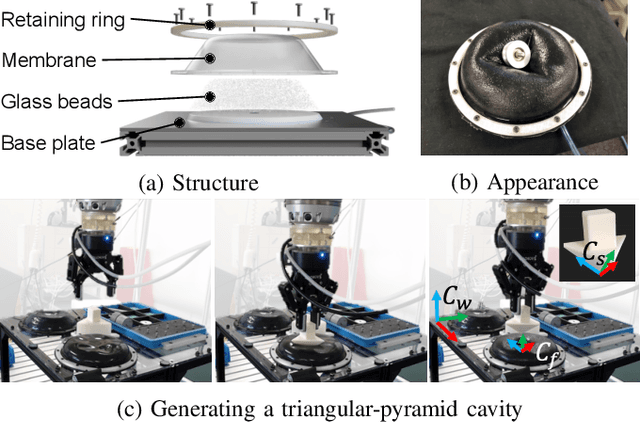
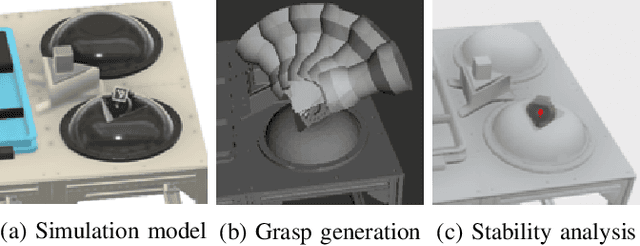

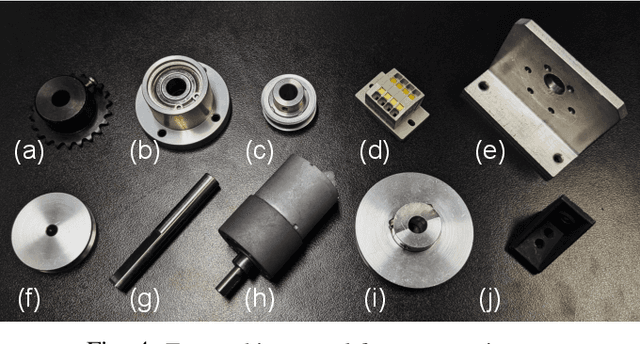
Abstract:Regrasping on fixtures is a promising approach to reduce pose uncertainty in robotic assembly, but conventional rigid fixtures lack adaptability and require dedicated designs for each part. To overcome this limitation, we propose a soft jig inspired by the jamming transition phenomenon, which can be continuously deformed to accommodate diverse object geometries. By pressing a triangular-pyramid-shaped tool into the membrane and evacuating the enclosed air, a stable cavity is formed as a placement space. We further optimize the stamping depth to balance placement stability and gripper accessibility. In soft-jig-based regrasping, the key challenge lies in optimizing the cavity size to achieve precise dropping; once the part is reliably placed, subsequent grasping can be performed with reduced uncertainty. Accordingly, we conducted drop experiments on ten mechanical parts of varying shapes, which achieved placement success rates exceeding 80% for most objects and above 90% for cylindrical ones, while failures were mainly caused by geometric constraints and membrane properties. These results demonstrate that the proposed jig enables general-purpose, accurate, and repeatable regrasping, while also clarifying its current limitations and future potential as a practical alternative to rigid fixtures in assembly automation.
A Multi-Level Similarity Approach for Single-View Object Grasping: Matching, Planning, and Fine-Tuning
Jul 16, 2025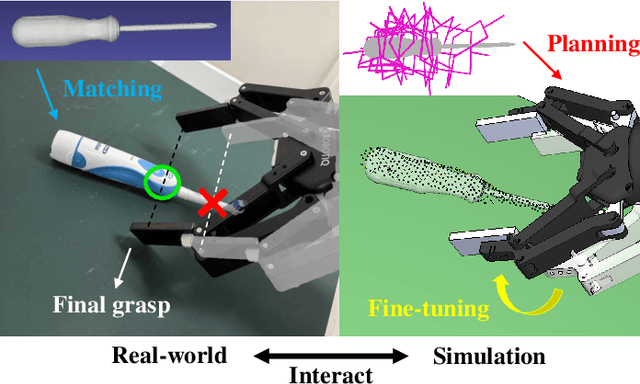

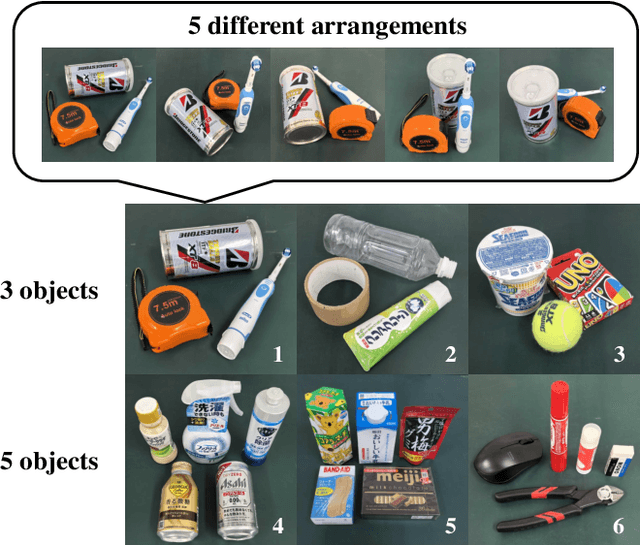
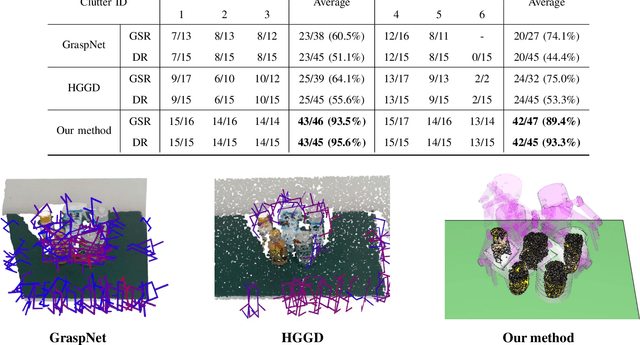
Abstract:Grasping unknown objects from a single view has remained a challenging topic in robotics due to the uncertainty of partial observation. Recent advances in large-scale models have led to benchmark solutions such as GraspNet-1Billion. However, such learning-based approaches still face a critical limitation in performance robustness for their sensitivity to sensing noise and environmental changes. To address this bottleneck in achieving highly generalized grasping, we abandon the traditional learning framework and introduce a new perspective: similarity matching, where similar known objects are utilized to guide the grasping of unknown target objects. We newly propose a method that robustly achieves unknown-object grasping from a single viewpoint through three key steps: 1) Leverage the visual features of the observed object to perform similarity matching with an existing database containing various object models, identifying potential candidates with high similarity; 2) Use the candidate models with pre-existing grasping knowledge to plan imitative grasps for the unknown target object; 3) Optimize the grasp quality through a local fine-tuning process. To address the uncertainty caused by partial and noisy observation, we propose a multi-level similarity matching framework that integrates semantic, geometric, and dimensional features for comprehensive evaluation. Especially, we introduce a novel point cloud geometric descriptor, the C-FPFH descriptor, which facilitates accurate similarity assessment between partial point clouds of observed objects and complete point clouds of database models. In addition, we incorporate the use of large language models, introduce the semi-oriented bounding box, and develop a novel point cloud registration approach based on plane detection to enhance matching accuracy under single-view conditions. Videos are available at https://youtu.be/qQDIELMhQmk.
Cooking Task Planning using LLM and Verified by Graph Network
Mar 27, 2025



Abstract:Cooking tasks remain a challenging problem for robotics due to their complexity. Videos of people cooking are a valuable source of information for such task, but introduces a lot of variability in terms of how to translate this data to a robotic environment. This research aims to streamline this process, focusing on the task plan generation step, by using a Large Language Model (LLM)-based Task and Motion Planning (TAMP) framework to autonomously generate cooking task plans from videos with subtitles, and execute them. Conventional LLM-based task planning methods are not well-suited for interpreting the cooking video data due to uncertainty in the videos, and the risk of hallucination in its output. To address both of these problems, we explore using LLMs in combination with Functional Object-Oriented Networks (FOON), to validate the plan and provide feedback in case of failure. This combination can generate task sequences with manipulation motions that are logically correct and executable by a robot. We compare the execution of the generated plans for 5 cooking recipes from our approach against the plans generated by a few-shot LLM-only approach for a dual-arm robot setup. It could successfully execute 4 of the plans generated by our approach, whereas only 1 of the plans generated by solely using the LLM could be executed.
Robotic Paper Wrapping by Learning Force Control
Mar 19, 2025



Abstract:Robotic packaging using wrapping paper poses significant challenges due to the material's complex deformation properties. The packaging process itself involves multiple steps, primarily categorized as folding the paper or creating creases. Small deviations in the robot's arm trajectory or force vector can lead to tearing or wrinkling of the paper, exacerbated by the variability in material properties. This study introduces a novel framework that combines imitation learning and reinforcement learning to enable a robot to perform each step of the packaging process efficiently. The framework allows the robot to follow approximate trajectories of the tool-center point (TCP) based on human demonstrations while optimizing force control parameters to prevent tearing or wrinkling, even with variable wrapping paper materials. The proposed method was validated through ablation studies, which demonstrated successful task completion with a significant reduction in tear and wrinkle rates. Furthermore, the force control strategy proved to be adaptable across different wrapping paper materials and robust against variations in the size of the target object.
Adaptive Grasping of Moving Objects in Dense Clutter via Global-to-Local Detection and Static-to-Dynamic Planning
Feb 09, 2025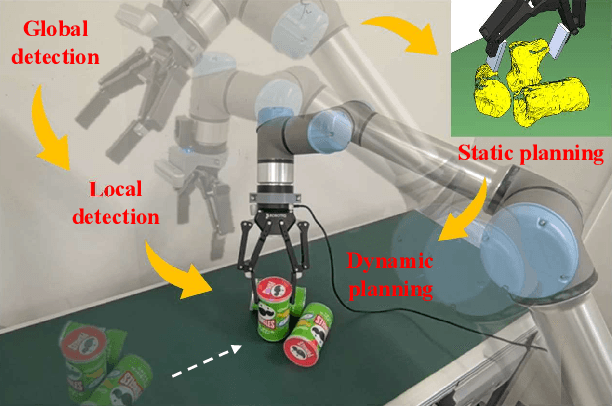



Abstract:Robotic grasping is facing a variety of real-world uncertainties caused by non-static object states, unknown object properties, and cluttered object arrangements. The difficulty of grasping increases with the presence of more uncertainties, where commonly used learning-based approaches struggle to perform consistently across varying conditions. In this study, we integrate the idea of similarity matching to tackle the challenge of grasping novel objects that are simultaneously in motion and densely cluttered using a single RGBD camera, where multiple uncertainties coexist. We achieve this by shifting visual detection from global to local states and operating grasp planning from static to dynamic scenes. Notably, we introduce optimization methods to enhance planning efficiency for this time-sensitive task. Our proposed system can adapt to various object types, arrangements and movement speeds without the need for extensive training, as demonstrated by real-world experiments.
Self-Supervised Learning of Grasping Arbitrary Objects On-the-Move
Nov 15, 2024

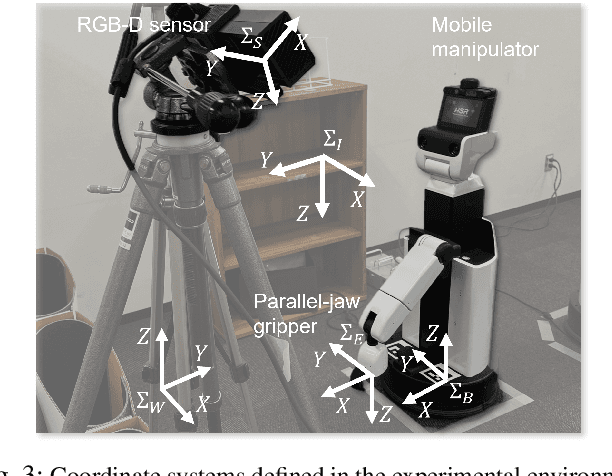

Abstract:Mobile grasping enhances manipulation efficiency by utilizing robots' mobility. This study aims to enable a commercial off-the-shelf robot for mobile grasping, requiring precise timing and pose adjustments. Self-supervised learning can develop a generalizable policy to adjust the robot's velocity and determine grasp position and orientation based on the target object's shape and pose. Due to mobile grasping's complexity, action primitivization and step-by-step learning are crucial to avoid data sparsity in learning from trial and error. This study simplifies mobile grasping into two grasp action primitives and a moving action primitive, which can be operated with limited degrees of freedom for the manipulator. This study introduces three fully convolutional neural network (FCN) models to predict static grasp primitive, dynamic grasp primitive, and residual moving velocity error from visual inputs. A two-stage grasp learning approach facilitates seamless FCN model learning. The ablation study demonstrated that the proposed method achieved the highest grasping accuracy and pick-and-place efficiency. Furthermore, randomizing object shapes and environments in the simulation effectively achieved generalizable mobile grasping.
Task-Difficulty-Aware Efficient Object Arrangement Leveraging Tossing Motions
Nov 06, 2024



Abstract:This study explores a pick-and-toss (PT) as an alternative to pick-and-place (PP), allowing a robot to extend its range and improve task efficiency. Although PT boosts efficiency in object arrangement, the placement environment critically affects the success of tossing. To achieve accurate and efficient object arrangement, we suggest choosing between PP and PT based on task difficulty estimated from the placement environment. Our method simultaneously learns the tossing motion through self-supervised learning and the task determination policy via brute-force search. Experimental results validate the proposed method through simulations and real-world tests on various rectangular object arrangements.
WasteGAN: Data Augmentation for Robotic Waste Sorting through Generative Adversarial Networks
Sep 25, 2024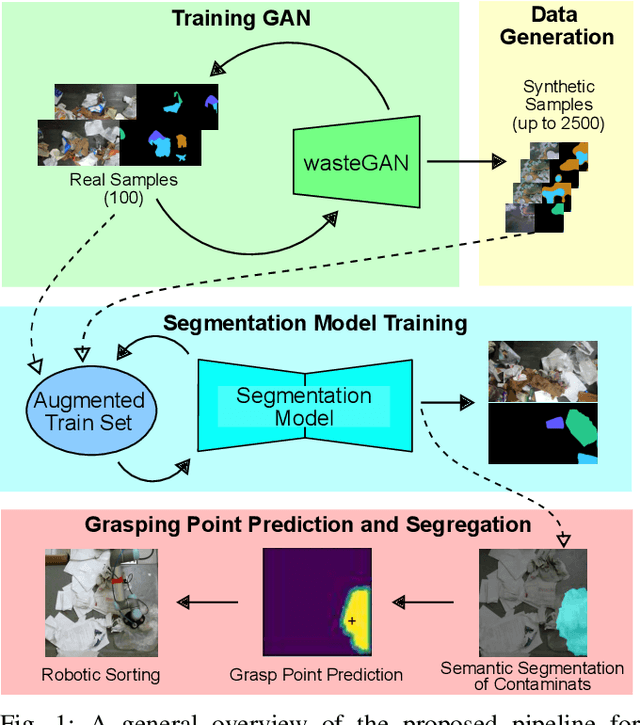
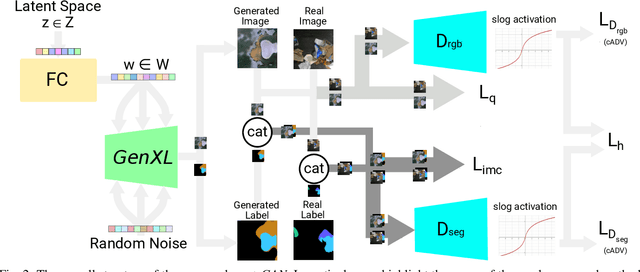
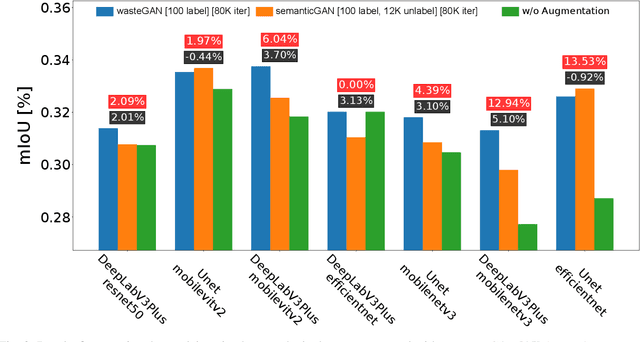
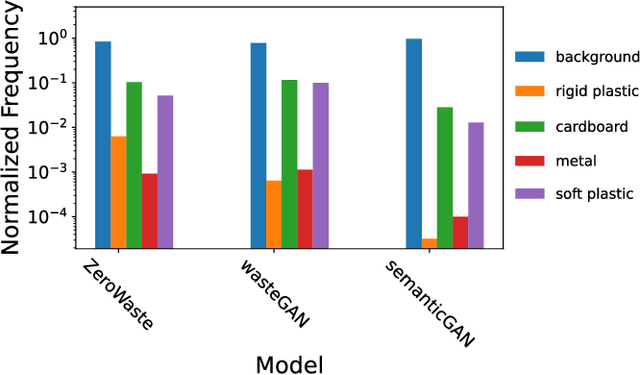
Abstract:Robotic waste sorting poses significant challenges in both perception and manipulation, given the extreme variability of objects that should be recognized on a cluttered conveyor belt. While deep learning has proven effective in solving complex tasks, the necessity for extensive data collection and labeling limits its applicability in real-world scenarios like waste sorting. To tackle this issue, we introduce a data augmentation method based on a novel GAN architecture called wasteGAN. The proposed method allows to increase the performance of semantic segmentation models, starting from a very limited bunch of labeled examples, such as few as 100. The key innovations of wasteGAN include a novel loss function, a novel activation function, and a larger generator block. Overall, such innovations helps the network to learn from limited number of examples and synthesize data that better mirrors real-world distributions. We then leverage the higher-quality segmentation masks predicted from models trained on the wasteGAN synthetic data to compute semantic-aware grasp poses, enabling a robotic arm to effectively recognizing contaminants and separating waste in a real-world scenario. Through comprehensive evaluation encompassing dataset-based assessments and real-world experiments, our methodology demonstrated promising potential for robotic waste sorting, yielding performance gains of up to 5.8\% in picking contaminants. The project page is available at https://github.com/bach05/wasteGAN.git
Component Selection for Craft Assembly Tasks
Jul 19, 2024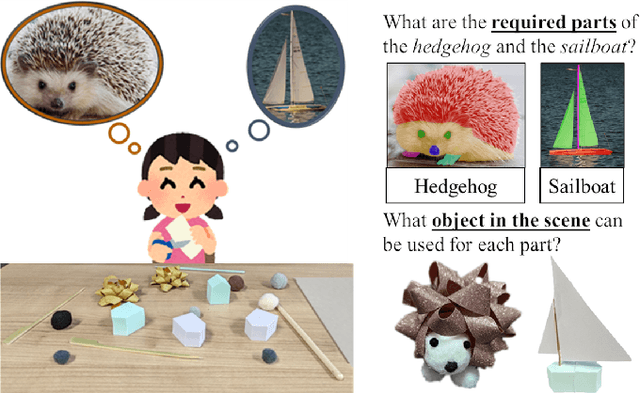
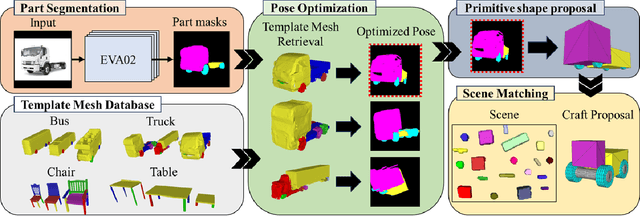
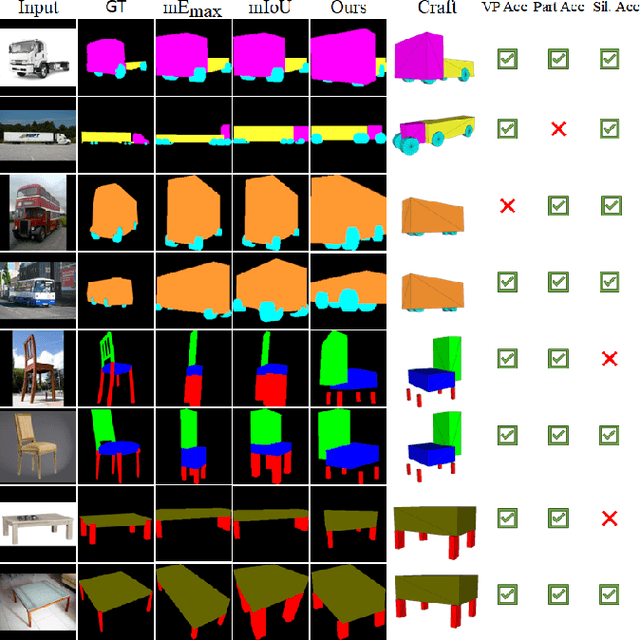
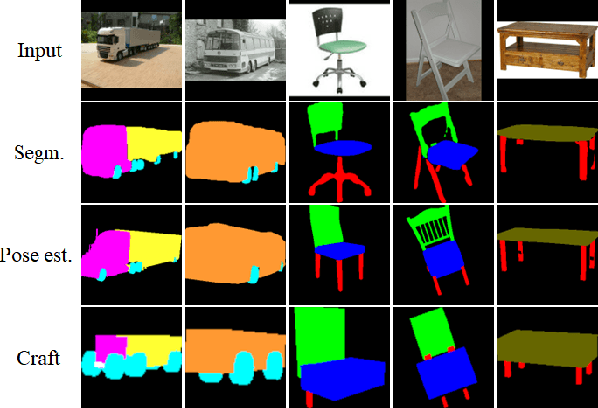
Abstract:Inspired by traditional handmade crafts, where a person improvises assemblies based on the available objects, we formally introduce the Craft Assembly Task. It is a robotic assembly task that involves building an accurate representation of a given target object using the available objects, which do not directly correspond to its parts. In this work, we focus on selecting the subset of available objects for the final craft, when the given input is an RGB image of the target in the wild. We use a mask segmentation neural network to identify visible parts, followed by retrieving labelled template meshes. These meshes undergo pose optimization to determine the most suitable template. Then, we propose to simplify the parts of the transformed template mesh to primitive shapes like cuboids or cylinders. Finally, we design a search algorithm to find correspondences in the scene based on local and global proportions. We develop baselines for comparison that consider all possible combinations, and choose the highest scoring combination for common metrics used in foreground maps and mask accuracy. Our approach achieves comparable results to the baselines for two different scenes, and we show qualitative results for an implementation in a real-world scenario.
 Add to Chrome
Add to Chrome Add to Firefox
Add to Firefox Add to Edge
Add to Edge